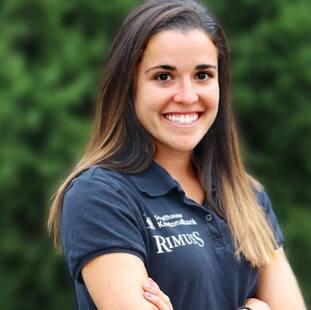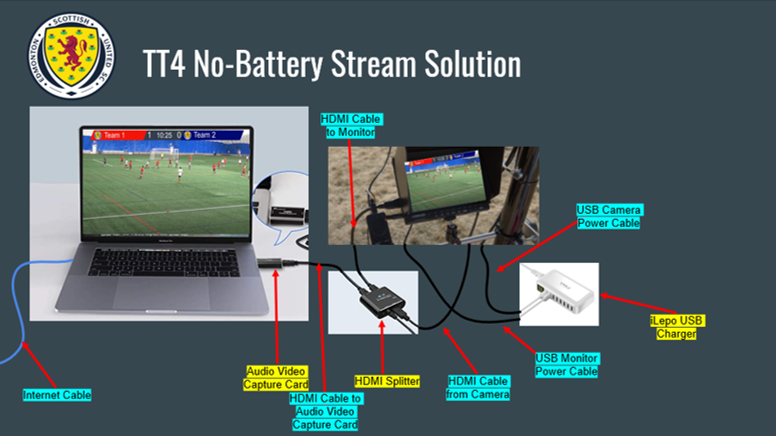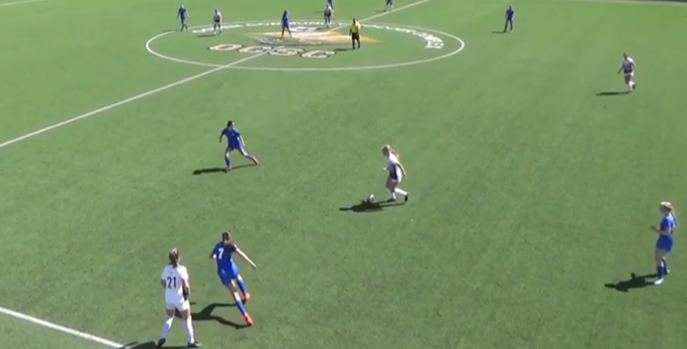|
Written by A. Rodrigues - Former Professional Soccer Player Using Film to Boost Your On-Field PerformanceWhen it comes to getting better as an athlete, everyone has heard the saying, “Practice makes perfect.” And although training on the field and in the gym can prepare you for game day physically, most sports take so much more than just muscle memory to excel. As an ex-professional soccer player and former Division I student-athlete, I learned firsthand that no matter how much I trained, both on my own and at team practices, nothing could replace developing my game IQ. And to better my understanding of the game—the ebb and flow of play-making, positioning, and team shape—I would need to do something more off the field and outside of the gym. I would need to watch game film. In soccer, we use film for so much more than just making a highlight video to send recruiters (but more on that later). We use it to evaluate our team, the other team, and even ourselves while we play to help better our performance for the next game. In this article, I’m going to be showing my firsthand account of how game footage has personally helped me advance my career from my earlier years in club ball than as a professional soccer player in Europe, while playing on two national teams (both Brazil and Portugal). Our Team If you’re doing your part on the field, focused on the task at hand, and holding yourself accountable in performing your best, it can be hard to concentrate on your team’s overall performance. After all, the responsibility of noticing a team’s weaknesses on the field and correcting them often lies with the coach, who has the power to make certain changes that a player often doesn’t have. However, looking back at film of a game or training, whether on your own or with the entire team, can help give you a better view as to what really happened out there regarding positioning, set plays or ball movement—whatever you may need to work on as a team. Team Film: How does your team move together? In soccer, there is a lot of creativity in play. It’s very seldom that you have certain “plays” that you need to follow, where every player knows where exactly they should run. One can only practice together so much during training and know which areas they should be covering according to their positions. Watching game film can help point out problem areas when it comes to following roles regarding set plays—whether or not I’ve been able to reach that first post or not during a corner kick or if I simply need to start my run earlier. It can help regarding defensive or offensive shape—is our right midfielder a little too wide when we lose the ball? Should our left-back be tucking in more to seal the hole in our flat back four? Having a team move perfectly in sync can be almost impossible—especially in such an unpredictable and creative sport. However, watching game film can help you or your team, as a whole, point out those minor mistakes that need to be adjusted or can help you or your coach identify an entire issue that may mean the difference between letting a goal in or not. Our Opponent Whether it was our Tuesday morning film session in college or our before-the-kickoff game footage of our next opponent on the National Team, we were able to gain an advantage heading onto the field that teams and coaches could only dream of decades ago. We had access to the other team’s playbook—their set plays, their formation, their key players—all in one easy-to-view video. Although some video quality was better than others, a bird’s eye perspective of how a team moves together and favors one side over another or one player over another definitely helped us strategize a way to best defend them. No matter if we were playing against a team from a completely different part of the world, where we would not be able to understand a word on the field that they were saying, we had the footage that spoke for the speechless. We were able to watch what they did and how they did it without understanding one word of what they said. It puts international games at an equal level. Team Film: Scouting out your opponent can help you prepare for your next game. Although you shouldn’t adjust the entire way your team plays in order to defend your next opponent, you should give them enough respect to see how they play and identify their strengths (and weaknesses). If you know No. 5 is a strong header off of corner kicks, game film is an opportunity to note that, take it into account in assigning your tallest player to mark her, and then adjust the play accordingly. You can also take note of their formation. If they are playing with three forwards and you have only three in the back as well, you may want to consider adding another defender back there so you always have one player open to sweep up the defense. In my career, especially on the national team and in college, we always watched footage of the opponent before our game. We either would watch the entire game to help get a feel of how they play as a whole or would watch clips of their highlights, so we would take note of their set plays, how they scored their goals or their weaknesses of how they got scored on. The film was pivotal for not only the coach to watch and plan our defense and attack accordingly, but also for the players to see, to truly grasp what was ahead. Watching film during a team video session can also be an effective opportunity to have the entire team there at once, so you can call out players on what they need to do for the next game and why based on your next opponent. Our Own Performance The final whistle blows, you walk off the field, exhausted. In your mind, you’ve just played the game of your life. You have no idea why your coach was yelling at you about your positioning or your defensive marking, etc. To you, your performance was nothing short of first-class, top-notch. However, that was just your perspective—and that’s the only perspective you’ve ever had access to. Not only did you experience the game through your eyes and through your eyes only, but you also have particular biases when it comes to how well you did—because we’re evaluating you. Film, on the other hand, is a whole other ball game—so to speak. What can I get out of watching a game that I’ve already played in? Think about it like a bird’s eye view. It gives you a completely different perspective—where you can view your game from outside of your own eyes. It had helped me see where I was in regard to positioning to other players and on the field as a whole. It had helped me see my decision-making from an entirely different perspective—I knew why I made the decision in the heat of the moment, but now, I can see what better decisions there were to be made. It had helped me see my strengths and my weaknesses, what I can train harder at my next practice, and what to pay attention to come next match. It helped me become a better player both individually and within the team. Game film gave me the best opportunity to see myself from an outsider’s perspective—and approach my performance with that same perspective, eliminating any adrenaline-game-bias or need to defend my own decisions. It also helps me put my best moments on the field in one place. Throughout my career, this has helped me nail my first impression and catch the eye of college coaches, pro teams, and other scouts. Film to Push You Forward Whether I was analyzing game footage with highlight clips of every time I touched the ball in the game with my head coach, whether we were watching the other team’s best (and worst) moments of their last match or whether my coach brought together the entire team to watch our last game and how we moved together, game film was always a part of my soccer career. Not watching game film to better yourself as an athlete or get better as a team together is like having access to the key to winning a match and not putting it in the door to unlock your potential. There’s something powerful about seeing something physically and having it resonate with you as a player. Whether you need to figure out how to start filming your games or practices or how to access that invaluable footage, doing so can be the missing piece your game has been needing to improve your performance and excel as an athlete. SVT Can Help
If you are trying to figure out options for filming your child, club, high school or even pro team, we at SVT are here to help. We would be glad to answer questions and discuss needs. Why should you choose to go with SVT? We work with clubs and teams across the US and several other countries. We have several packages to choose from. Our Package 3 is the most popular and consists of a strong, lightweight aluminum tripod with a sturdy 16-foot carbon-fiber composite camera pole, plus a monitor and remote. We provide power packs and all of the cables and cords that you need to make the system work together. Once you purchase our system – use it as much as you like. There are no contracts. Contact us today for more information.
0 Comments
Notes: We have an updated landing page to provide helpful information on livestreaming. Click here to visit the page. Additional resources are included at the end of this blog. Live Streaming Sports Using Your Phone2020 has been a year of fast change and disruption. We’ve gone from having families and friends attending youth soccer, lacrosse and football games to, in some cases, no spectators. For those areas that allow spectators, social distancing and mask wearing are required and those who are more vulnerable to getting sick are not able to attend. We’ve been asked by teams all over about live streaming sports. This is not currently a simple answer. But for the interim, we hope the following will help. Disclaimer & Helpful Up-Front Tip This is not a perfect process, and we are not streaming or “Facebook live” experts. But we hope it helps those really struggling to find a way to live stream your sporting events. We would love to hear back from you if you find tweaks or better ways to do this. For this process, we would highly recommend that two people be involved. One person needs to focus on filming. The other person should handle the streaming portion. Camera, Positioning, Awareness and Quality We’ve tested out a few different platforms using cell phones. However, in all cases, the quality and ability to see what was going on, especially across the field, was very difficult. Being up in bleachers helped and provided perspective on spacing. But it was still really difficult to see the play action in many points across the field. The digital zoom was grainy and trying to hold the camera steady becomes a problem. You also need to be aware that most everything you say, and those around you, will likely be live-streamed as well if the camera is not elevated. Comments from close by parents, fans and yourself will be broadcast. We also tested out cameras, like the yi 4K+Action Camera mounted to the top of the SVT Advantage Tower. This camera allows for streaming through Facebook Live and your mobile hotspot – which was really nice. Again, the footage was not too good due to the fish-eye lens causing distortion. It was also really hard to see the game when the ball was on either side of the field. To really be able to see the game, we found that we needed to use a good quality camera with an optical zoom, without fish-eye distortion, elevated above the field at least 16 feet for a football field, soccer field or a lacrosse field. Live Streaming Hardware & Software After reading a lot of reviews and viewing a lot of videos, we finally found a set-up that allowed for us to connect and stream the output from a camcorder. It is not perfect, requires a little patience and practice, and we are working on refining options, but we were able to get this to work. In additional to our SVT Camera Tower and a laptop with a USB 3.0 port, we purchased:
We had to download OBS Studio (free open source software). It can be downloaded from https://obsproject.com/. You Need Signal Strength An important item to know is that you need decent 4G signal strength for this to work. If you are in the middle of now-where without good signal, it will be very difficult to be able to stream anything. Now to Live Streaming After setting up the SVT Tower, you will need to connect the HDMI cable coming down from the camera to the Mokose Box (input). Use the new HDMI cable and connect the one end to the Mokose output, and connect the other end to the monitor. Turn on the hotspot on your cell phone and connect the computer to that hotspot. The Mokose Capture Device comes with a USB 3.0 cable. You’ll need to connect one end of the USB cable into the Mokose port and the other end into a USB 3.0 port on your laptop. Your computer should install the Mokose driver automatically. To run the OBS software, there are several really good YouTube tutorials. One that was very helpful was https://www.youtube.com/watch?v=DTk99mHDX_I Here are the steps we followed to start streaming: Open OBS Studio and click on the “+” under “Sources”. We selected “Video Capture Device” then select “Mokose”. In the Properties for “Video Capture Device”, change the Audio Device to “Mokose”. You'll also need to go into advanced settings and change the audio input microphone to be their laptop’s microphone instead of the webcam’s microphone. Next, select “Settings” in the bottom right of the OBS dashboard and go to streaming. You’ll need to select your streaming service as well as get your “Stream Key”. For helps with how to do this – there are lots of YouTube videos on getting the stream key - which varies with the streaming service. Some of these methods change, so look for the most recent videos. Start Streaming You should now be set up to start livestreaming. Just click on “Start Streaming” on the bottom right of the OBS studio screen. SVT Can Help We hope this will be helpful to those trying to live stream sports “on a budget”. This was not a seamless process and took some time to figure out. So please feel free to send us helps and thoughts. We will continue to improve technologies for you to instruct and capture film of your sport teams. Why should you choose to go with SVT? We work with clubs and teams across the US and several other countries. We have several packages to choose from. Our Package 3 is the most popular and consists of a strong, lightweight aluminum tripod with a sturdy 16-foot carbon-fiber composite camera pole, plus a monitor and remote. We provide power packs and all of the cables and cords that you need to make the system work together. Once you purchase our system – use it as much as you like. There are no contracts. Contact us today for more information. Additional Help 1 We received the slide deck below from Scylla with the Edmonton Scottish United club on what they were using to live-stream their soccer games. The set-up could be used to live stream lacrosse or football as well. Thanks for putting this together. Pictures of the slide deck are below as well as a downloadable pdf with each component hyperlinked. Please also check out the attached helpful comment on additional options.
Additional Help 2 We'd like to thank Mr. O'Driscoll for sending in the video below on the system he and several others developed for live streaming. This set-up does not require a computer, allowing for less hassel. For questions - please e-mail to k.odriscoll@thewinnercircle.net. Soccer Film Study - Best PracticesFilming sports for film study is something some top coaches are utilizing to improve the vision and game IQ of their players. Stadium and tower camera systems are becoming a common site on fields across the US. In-line with this trend is the growing skill level of players. Players today are utilizing tools never available before to improve their fitness and level of play.
Recording games has become a great tool for many coaches looking to help mentally train their teams. To help coaches struggling to improve how they do film study, or even figure out where to start, we travelled with one elite soccer club team to several matches around the country. This included National League, State Cup and the US Youth National Championship. It was great to see how video was used by this team to help train their players. Below are a few observations we noted. Set The Time During a tournament, at least one hour each day was dedicated to reviewing game footage from that day. The microSD card was removed from the camcorder and the coach, players and parents reviewed situations from the recorded soccer match. Having the ability to watch the game footage from that day, while the game was still fresh in their minds, was helpful. What was also impressive was how the coach used film for situational analysis - improving their soccer IQ. The coach would show a given play or condition and then freeze the film. Players would weigh in on how they would react or play, giving their reasons for their choice. You could see the critical thinking of the players improving as they listened to each other and then their coach. Parents would learn and become more involved in understanding the game and also understand how to assist and support the players and coaches. Pre-Planning Film Review This was another “Best Practice” we observed. The coach would have several players review the soccer game film before the rest of the team met for film review. He would ask the players to look at specific events during the game and provide their insight to the team on their thoughts. Examples may be to focus on specific set plays, transitions during a specific portion of the game, or defensive positioning. This again helped the players to improve their critical thinking and learn how to communicate it. It was clear the coach understood that thinking and communication of their reasoning was a two-part process. Being able to ask the players to dissect a game at specific points, as well as to do a situational analysis, required that the coach spend a few moments pre-planning. By having the players do some of the teaching and analysis, it really did not take too much time. The critical part was making sure a few key points were learned from each soccer film session. Stats Versus Behavior Statistics on a player are always good to gather, but they don’t tell the whole story. During film review, the coach would use film to help educate the team on behavior. For example, a star forward who would be very aggressive on the attack, but then stop and even somewhat pout when the ball was lost, losing the opportunity to help defend, could see the negative effect on the team. The stat was to get the goal, but the behavior if the ball was lost was hurting the other teammates. Positive Training It was really enjoyable to watch the coach build the players as they did film study. Their approach was not to focus on the things they did wrong – which they did address. They approached film study as a way to train the group on critical thinking. Whether they handled a situation right or wrong on the field, they did not dwell on that. The focus was on how to think through a situation. Since soccer requires a lot of critical thinking (position awareness, spacing, pace…), the more exposure players have to effective methods the better. Once the players capture the vision, the practice becomes more effective. Individual Reflection Training Another thing this coaching staff did was to ask the girls to watch 5 minutes of their soccer play and watch certain key skills and habits. These included:
Compare Personal Play with the Professionals Last of all the coach would ask players to watch soccer film from a professional game. The players could then compare it to how they would approach a situation. In some cases, the coach would bring footage in from a professional game and freeze the film at specific points, such as when there was a transition. The coach would then ask for thoughts on where the next pass should go, or where a certain player should be moving. After some discussion, they would see what the professional player decided to do. Again, a great way for players to improve their critical thinking and soccer IQ. SVT Can Help Film study provides a great opportunity for players to really visualize the game, develop a higher soccer IQ and communicate clearer. It helps them really see what is/was happening on the field and compare it to their perception. We at SVT look forward to helping you film your sport. SVT provides economical and very mobile camera towers to help you record soccer games easier. Why should you choose to go with SVT? We work with clubs and teams across the US and several other countries. We have several packages to choose from. Our Package 3 is the most popular and consists of a strong, lightweight aluminum tripod with a sturdy 16-foot carbon-fiber composite camera pole, plus a monitor and remote. We provide power packs and all of the cables and cords that you need to make the system work together. Once you purchase our system – use it as much as you like. There are no contracts. Contact us today for more information. |
AuthorSVT Advantage Archives
May 2023
Categories |
||||||





 RSS Feed
RSS Feed